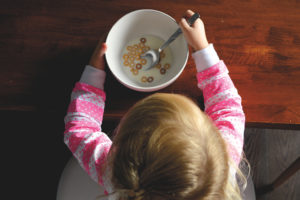
It’s well-known that Americans consume too much sugar. But that affinity for the sweet stuff starts as early as infancy, with some babies consuming added sugar that exceeds maximum levels recommended for adults, U.S. researchers report.
Eating foods with added sugar can influence a child’s food choices later in life. And added sugar has been linked with obesity, asthma, dental cavities and heart disease risk factors such as high cholesterol and high blood pressure, the study authors said.
Our Take
Kristi Veltkamp, outpatient dietitian at Spectrum Health Blodgett Hospital, recommends we keep added sugars to less than 10 percent of our total daily calories (or about 50 grams on average or 12 teaspoons). Most Americans average 20 or more teaspoons.
You might say you do not add 12 teaspoons of sugar to any particular food, but it is the hidden. Added sugars in processed foods is often what gets Americans in trouble.
Take a look at some common foods. You might be surprised how much sugar is included:
- Nature Valley granola bar (for both bars in a package): 12 grams
- Ketchup: 4 grams in 1 tablespoon
- Chobani flavored Greek yogurt: 9 to 19 grams in a 6-ounce container (some of which is natural sugar)
- Pure Leaf peach tea: 46 grams per 18.5-ounce bottle
- Honey Nut Cheerios: 9 grams in ¾ cup
- Frosted Mini Wheats: 11 grams per 1 cup
- Barbecue sauce: 5-15 grams per 2 tablespoons
- Gatorade: 39 grams per 20-ounce bottle
- Frozen margarita: upwards of 40 or more grams in a 12-ounce drink
Be a label investigator and learn about what you are eating. Try to eat less than the maximum recommendation of 50 grams per day. Track sugar intake for one day and learn how well you are doing.
The researchers analyzed data from 800 infants and toddlers between 6 and 23 months old in the 2011-14 U.S. National Health and Nutrition Examination Survey.
They found that 85 percent of the infants and toddlers consumed added sugar on a given day and that added sugar consumption rose with age.
Just over 60 percent of those ages 6 to 11 months averaged just under 1 teaspoon of added sugar a day. That rose to 98 percent among those babies 12 to 18 months, who averaged 5.5 teaspoons of added sugar a day.
And a whopping 99 percent of babies 19 to 23 months old averaged just over 7 teaspoons of added sugar on a given day, more than the amount in a Snickers candy bar, the study authors said.
The added sugar included cane sugar, high-fructose corn syrup and honey.
Daily recommended limits for added sugar are 6 teaspoons or less a day for children 2 to 19 years old and for adult women, and 9 teaspoons or less a day for adult men.
But most Americans exceed those limits.
The study findings are scheduled for presentation at the American Society for Nutrition annual meeting in Boston.
“This is the first time we have looked at added sugar consumption among children less than 2 years old,” said lead study author Kirsten Herrick, a nutritional epidemiologist at the U.S. Centers for Disease Control and Prevention.
“Our results show that added sugar consumption begins early in life and exceeds current recommendations. These data may be relevant to the upcoming 2020-2025 Dietary Guidelines for Americans,” she said in a society news release.
“The easiest way to reduce added sugars in your own diet and your kids’ diet is to choose foods that you know don’t have them, like fresh fruits and vegetables,” Herrick suggested.
Research presented at meetings is considered preliminary until published in a peer-reviewed medical journal.
 /a>
/a>
 /a>
/a>
 /a>
/a>